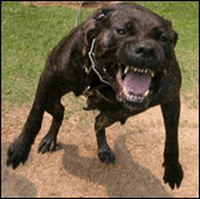Under the 1991 Act (and as amended in 1997) it is illegal to own any Specially Controlled Dogs without specific exemption from a court. The dogs have to be muzzled and kept on a lead in public, they must be registered and insured, neutered, tattooed and receive microchip implants. The Act also bans the breeding, sale and exchange of these dogs, even if they are on the Index of Exempted Dogs.[1][dead link]
Four types in particular were identified by the Act:
Pit Bull Terrier
Japanese Tosa
Dogo Argentino
Fila Brasileiro
The Act also covers cross breeds of the above four types of dog. Dangerous dogs are classified by 'type', not by breed label. This means that whether a dog is prohibited under the Act will depend on a judgement about its physical characteristics, and whether they match the description of a prohibited 'type'. This assessment of the physical characteristics is made by a court.
The Act applies in England, Wales and Scotland,[2] with The Dangerous Dogs (Northern Ireland) Order 1991 having a similar effect in Northern Ireland.
 most dangerous dog
most dangerous dog most dangerous dog
most dangerous dogThe Index of Exempted Dogs
The Index of Exempted Dogs is maintained by the Animal Welfare section of the Department for Environment, Food and Rural Affairs, which administers the registration of specially-controlled dogs in England and Wales.
In 1991 and 1992 details of all Specially Controlled Dogs and their owners and keepers had to be added to the Index of Exempted Dogs. From early 1992 to 1997 no dogs were allowed to be added to the Index. In 1997 The Dangerous Dogs (Amendment) Act 1997 was passed which made some changes. From 1997 any Court was able to order that a specific dog be added to the Index by the issue of a Court Order.
Under the 1991 Act as amended it remains illegal to own any of these dogs without specific exemption from a court. The dogs have to be muzzled and kept on a leash in public, they must be registered and insured, neutered, tattooed and receive microchip implants.
Case law
There have been several test cases of the Act, most famously Dempsey (a pit bull terrier) who in 1995 was finally reprieved from a destruction order, to widespread media attention. The definition of the word "type" in the legislation was of particular controversy, as was the lack of discretion that the Act gives magistrates.
 most dangerous dog
most dangerous dog most dangerous dogCriticism of the Act
most dangerous dogCriticism of the ActThe Act has been described as a piece of rushed legislation which was an overreaction to a transient public mood. The Act is sometimes cited as an unfavourable example of such legislation, and in January 2007 was included in public responses to a BBC Radio 4 poll of unpopular UK legislation.
[edit] Comparable legislation elsewhere
Many other countries also have laws pertaining to dangerous dogs. These vary in severity. In some jurisdictions in Australia dogs which have been declared dangerous are required to wear a collar of red and yellow stripes; under the legislation of some municipalities of Queensland, such dogs are seized and destroyed. In some local government areas restrictions are very carefully spelt out.
 Top 10 dangerous dog
Top 10 dangerous dog Top 10 dangerous dog
Top 10 dangerous dog Top 10 dangerous dog
Top 10 dangerous dog Top 10 dangerous dog
Top 10 dangerous dog Top 10 dangerous dog
Top 10 dangerous dog Top 10 dangerous dog
Top 10 dangerous dog
No comments:
Post a Comment